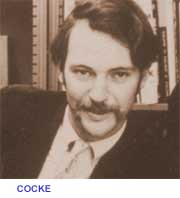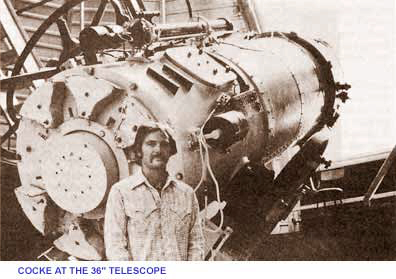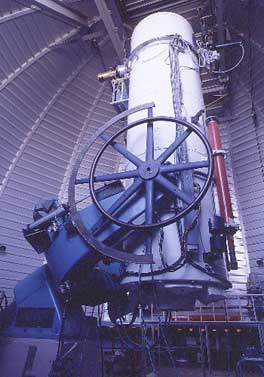 COCKE: Disney's a very outgoing type, and as it turned out, we both arrived in Tucson about the same time, in the middle of August, in '68, I guess that was. We were both staying at the same motel before—you know, while we were looking for a more permanent place to live.
COCKE: Disney's a very outgoing type, and as it turned out, we both arrived in Tucson about the same time, in the middle of August, in '68, I guess that was. We were both staying at the same motel before—you know, while we were looking for a more permanent place to live.
And so as I recall, my wife and I met Disney and his wife at the swimming pool, at the motel, and started talking about what we were doing in Tucson, and it turned out that we were both astronomers and were both going to be at Steward Observatory.
 DISNEY: Well, I felt completely out of my depth there, and there were all these clever people rushing up and down mountains and measuring real stars and things, and telescopes, and I was a pure theoretical astronomer and I didn't really know what a real telescope looked like.
DISNEY: Well, I felt completely out of my depth there, and there were all these clever people rushing up and down mountains and measuring real stars and things, and telescopes, and I was a pure theoretical astronomer and I didn't really know what a real telescope looked like.
COCKE: We had both thought that it would be a good thing to get experience at the telescope, just as a thing in itself. And we had also thought from time to time about doing something really relative to pulsars. Everyone was interested in them, I suppose, when they were discovered. It immediately became a very, very popular thing to try and work on. What we proposed to do first was to search known white dwarfs for optical pulsations.
DISNEY: Well, the first thing we did was to apply for some observing time, which much to our amazement we got a little bit of: thus, 3 or 4 nights on a rather small telescope—on the 36" telescope at Steward. These types of experiments were usually done by people with colossal telescopes and all sorts of modern equipment. And in fact we would never have got time, I don't think—being complete novices—on a decent large telescope. So it was kind of fortunate for us that we did have a small telescope. So they said, "Oh well, they'll only waste two or three nights on a small telescope anyway." Well, it was very funny, really, because they thought, first of all, it was a huge joke that two theoreticians were going to observe anyway. I mean, it's a kind of stock joke they have in all observatories that anybody who uses a pen and pencil and his brain and mathematics is totally hopeless with his fingers and is bound to put his foot through or his fingers through all the equipment and so on and can't observe. So there were jokes all around the Observatory which we took in fairly good spirit, because we kind of agreed with everybody.

But a couple of things completely changed the whole outlook of what we were doing. First of all, a paper arrived from Australia of an English astronomer out there called Mike Lodge who discovered another pulsar which was near a supernova remnant. Now, it'd been predicted all along that the place you would find a neutron star would be close to or inside a supernova remnant. And more importantly, this new pulsar that Mike Lodge had discovered, was a very, very fast one. It pulsed on and off 11 times a second.
 |
| University of Arizona's 36" telesciope at Kitt Peak |
MORRISON: That made everyone realize that you couldn't turn a whole star's radio emission on and off that fast, no matter what you did. And the only answer—and there was an answer available and everyone began to believe that then—was that the star that was doing the radio pulsing—that the pulsar must be a very tiny star indeed. We knew of two small kinds of stars. Let me call them condensed stars—that's what we tend to call them. There is a class of star called a white dwarf. White dwarf matter is the most condensed form of normal matter with nuclei and electrons that we know about. And if you make a star out of white dwarf matter, the star shrinks down to the size of a planet a few thousand miles across. And so such a star might somehow emit pulses maybe a second or a half-second or just possibly a tenth of a second but hardly very sharp ones that were sharp compared to the tenth of a second spacing. And so the possibility that a white dwarf was the source of the pulsars that we heard was still—I think, as I recall it—I still thought it was an open question, but it didn't look very good.
Because of course there is another kind of matter, and another kind of condensed star that goes with it, and that is what people call a neutron star. It is one big nucleus. The electrons have disappeared entirely or almost entirely, and in their place is nothing but nuclear matter. But not a single nucleus, but nuclei fused together, so you have one nucleus as big—well, as massive as the sun, but of course enormously condensed—little condensed objects as massive as maybe one-half or one-fifth or one-tenth the star they started from. But only as big—no longer as big as a star or as big as a planet—but only as big as a mountain. And of course, spinning, because everything spins. And as you know, as you make something smaller it tends to spin more and more rapidly. And now that thing—you see it only takes light a ten-thousandth of a second to cross that star—and so that can be expected to make quick pulses.
